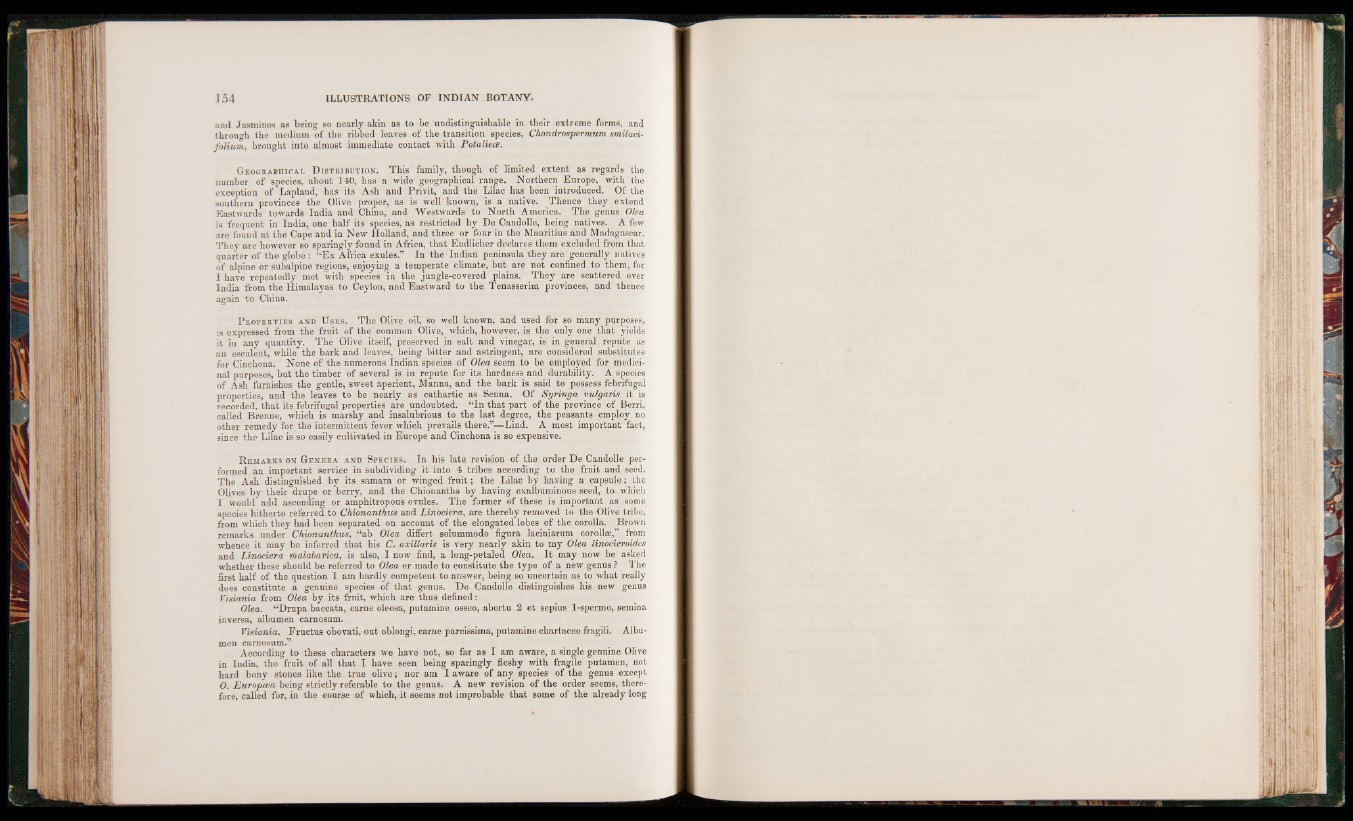
and Jasmines as being so nearly akin as to be undistinguishable in their extreme forms, and
through the medium of the ribbed leaves of the transition species, Chondrospermum smilaci-
folium, brought into almost immediate contact with Potaliece.
Geographical D istribution. This family, though of limited extent as regards the
number of species, about 140, has a wide geographical range. Northern Europe, with the
exception of Lapland, has its Ash and Privit, and the Lilac has been introduced. Of the
southern provinces the Olive proper, as is well known, is a native. Thence they extend
Eastwards towards India and China, and Westwards to North America. The genus Oka
is frequent in India, one half its species, as restricted by De Candolle, being natives. A few
are found at the Cape and in New Holland, and three or four in the Mauritius and Madagascar.
They are however so sparingly found in Africa, that Endlicher declares them excluded from that
quarter of the globe: “Ex Africa exules.” In the Indian peninsula they are generally natives
of alpine or subalpine regions, enjoying a temperate climate, but are not confined to them, for
I have repeatedly met with species in the jungle-covered plains. They are scattered over
India from the Himalayas to Ceylon, and Eastward to the Tenasserim provinces, and thence
again to China.
P roperties and U ses. The Olive oil, so well known, and used for so many purposes,
is expressed from the fruit of the common Olive, which, however, is the only one that yields
it in any quantity. The Olive itself, preserved in salt and vinegar, is in general repute as
an esculent, while the bark and leaves, being bitter and astringent, are considered substitutes
for Cinchona. None of the numerous Indian species of Olea seem to be employed for medicinal
purposes, but the timber of several is in repute for its hardness and durability. A species
of Ash furnishes the gentle, sweet aperient, Manna, and the bark is said to possess febrifugal
properties, and the leaves to be nearly as cathartic as Senna. Of Syringa vulgaris it is
recorded, that its febrifugal properties are undoubted. “In that part of the province of Berri,
called Brenne, which is marshy and insalubrious to the last degree, the peasants employ no
other remedy for the intermittent fever which prevails there.”—Lind. A most important fact,
since the Lilac is so easily cultivated in Europe and Cinchona is so expensive.
R emarks on Genera and Species. In his late revision of the order De Candolle performed
an important service in subdividing it into 4 tribes according to the fruit and seed.
The Ash distinguished by its samara or winged fru it; the Lilac by having a capsule; the
Olives by their drupe or berry, and the Chionanths by having exalbuminous seed, to which
I would add ascending or amphitropous ovules. The former of these is important as some
species hitherto referred to Chionanthus and Linociera, are thereby removed to the Olive tribe,
from which they had been separated on account of the elongated lobes of the corolla. Brown
remarks under Chionanthus, “ab Olea differt solummodo figura laciniarum corollse,”- from
whence it may be inferred that his C. axillaris is very nearly akin to my Olea linocieroides
and Linociera malabarica, is also, I now find, a long-petaled Olea. I t may now be asked
whether these should be referred to Olea or made to constitute the type of a new genus ? The
first half of the question I am hardly competent to answer, being so uncertain as to what really
does constitute a genuine species of that genus. De Candolle distinguishes his new genus
Visiania from Olea by its fruit, which are thus defined:
Olea. “Drupa baccata, came oleosa, putamine osseo, abortu 2 et sepius 1-spermo, semina
jnversa, albumen carnosum.
Visiania. Fructus obovati, out oblongi, came parcissima, putamine chartaceo fragili. Albumen
carnosum.”
According to these characters we have not, so far as I am aware, a single genuine Olive
in India, the fruit of all that I have seen being sparingly fleshy with fragile putamen, not
hard bony stones like the true olive; nor am I aware of any species of the genus except
O. Europcea being strictly referable to the genus. A new revision of the order seems, therefore,
called for, in the course of which, it seems not improbable that some of the already long